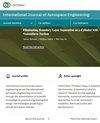Reentry Capsule Reachable Tube Boundary Prediction via Evolutionary Multiobjective Optimization
IF 1.2
4区 工程技术
Q3 ENGINEERING, AEROSPACE
引用次数: 0
Abstract
In the field of aerospace, solving the boundary problem associated with the parachute-capsule system remains a big challenge. The conventional Monte Carlo method proves inadequate for acquiring comprehensive boundary information. To address this issue, this paper introduces a novel tube prediction scheme by leveraging the natural geometric characteristics of the reachable tube and employing a multiobjective optimization strategy. Initially, a multibody dynamic model with nine degrees of freedom was established and verified by the airdrop test data to ensure the accuracy and reliability of the model. Subsequently, the Sobol sensitivity analysis method was employed to assess uncertain factors that affect the deceleration phase of the reentry capsule. These factors are then utilized to determine the optimization parameters for the multiobjective optimization model. Ultimately, the multiobjective evolutionary algorithm based on decomposition was employed to solve the multiobjective optimization model, and the geometric boundary of the tube corresponds to the Pareto front of the multiobjective optimization. The proposed methodology was validated through a simulation experiment utilizing the Chang’e-5 reentry capsule as an engineering case. The experimental results unequivocally demonstrate the superior accuracy of our approach in predicting the boundary of the reachable tube compared to the Monte Carlo method. This research serves as a valuable reference for calculating reachable tubes in practical engineering scenarios and can be effectively applied to spacecraft search and rescue operations during the reentry phase.通过进化多目标优化预测再入太空舱可到达管道边界
在航空航天领域,解决与降落伞-胶囊系统相关的边界问题仍然是一个巨大的挑战。事实证明,传统的蒙特卡罗方法不足以获取全面的边界信息。为解决这一问题,本文利用可到达管道的自然几何特征,并采用多目标优化策略,提出了一种新型管道预测方案。首先,建立了一个具有九个自由度的多体动态模型,并通过空投测试数据进行验证,以确保模型的准确性和可靠性。随后,采用 Sobol 敏感性分析方法评估影响再入太空舱减速阶段的不确定因素。然后利用这些因素来确定多目标优化模型的优化参数。最终,采用基于分解的多目标进化算法来求解多目标优化模型,管子的几何边界对应于多目标优化的帕累托前沿。以嫦娥五号返回舱为工程案例,通过仿真实验对提出的方法进行了验证。实验结果清楚地表明,与蒙特卡洛方法相比,我们的方法在预测可到达管道边界方面具有更高的准确性。这项研究为在实际工程场景中计算可达管提供了有价值的参考,并可有效应用于返回阶段的航天器搜救行动。
本文章由计算机程序翻译,如有差异,请以英文原文为准。
求助全文
约1分钟内获得全文
求助全文
来源期刊

International Journal of Aerospace Engineering
ENGINEERING, AEROSPACE-
CiteScore
2.70
自引率
7.10%
发文量
195
审稿时长
22 weeks
期刊介绍:
International Journal of Aerospace Engineering aims to serve the international aerospace engineering community through dissemination of scientific knowledge on practical engineering and design methodologies pertaining to aircraft and space vehicles.
Original unpublished manuscripts are solicited on all areas of aerospace engineering including but not limited to:
-Mechanics of materials and structures-
Aerodynamics and fluid mechanics-
Dynamics and control-
Aeroacoustics-
Aeroelasticity-
Propulsion and combustion-
Avionics and systems-
Flight simulation and mechanics-
Unmanned air vehicles (UAVs).
Review articles on any of the above topics are also welcome.
 求助内容:
求助内容: 应助结果提醒方式:
应助结果提醒方式:


